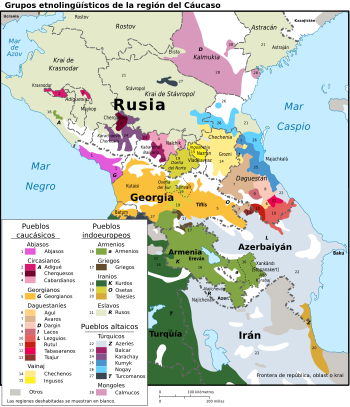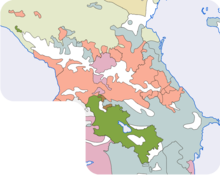Caucasian languages
The term Caucasian languages is used informally to refer to a large and extremely diverse group of languages spoken by more than 7 million speakers in southeastern Eastern Europe, between the Black Sea and the Caspian Sea. Linguistic studies classify these languages into various families with little or no affinity between them. Some of these language families do not have members outside the Caucasus area.
Language families
All the languages spoken in the Caucasus have been able to be phylogenetically related to languages inside or outside the Caucasus itself, so it is considered that there is no isolated language in the region. The phylogenetic groups or families obtained by comparison can be divided from a convenience point of view between "indigenous" and "alochthonous" families.
Indigenous families of the Caucasus
Comparative work on the non-Indeo-European and non-Turkic languages of the Caucasus have made it possible to establish that they belong to three disjoint families, in principle unrelated. These three families of languages spoken exclusively in the Caucasus region are:
- South Caucasian languagesalso called the Caucasian family of the South, Georgian or Kartvelian languages. It includes the Georgian (official language of Georgia), the suano or svan, and two very close languages: the loop or laz and the mingrelio or magreliano.
- Northern Caucasian languages
- Northwest Caucasian familyAlso called Abkhaz-adygh family or circasiana. It includes three branches: the abbey with the Abkhaz, the circasian and the cabardian, and the ubiquitous. Some scholars include in the family the hatti, a former missing language spoken in Anatolia.
- Northeast Caucasian family or Nakh-Dagostan.
- Caucasian family of the north center, also called the vaynakh family. Includes the báico or bats, the Chechen and the ingusetio.
- Languages of the Dagestan.
Some scholars have proposed that the two northern families could form a hypothetical Norcaucásic family, which have even tried phonological reconstructions and etymological dictionaries have been published. However, most specialists consider that these works present Some methodological problems and are not conclusive.
Alóctonas del Caucaso Families
Other languages of Caucasus can be included in families with a broader geographical distribution than Caucasus himself. In principle, the oldest traceable origin of these languages is alóctone and would be outside the Caucasus. Among these languages are:
- Indoeuropeas:
- Armenian
- Iranian languages:
- Northeast: Oseta
- Northwest: Talish
- Southwest: Tati and Judeotati
- Turkey:
- Southwest:
- Azerbaijan
- Northwest:
- Cumuco
- Language karachái-bálkaro
- Balkar
- Karachay
- Nogayo
- Southwest:
- Mongols:
- Calmuco
To see a more detailed classification of these languages, see the articles of the corresponding families.
Affinities with other languages
The origin of the Indo-European and Turkic language families also spoken in the Caucasus seems to lie clearly outside the Caucasus. However, the origin of "indigenous" and the relationship with other languages outside the Caucasus is a topic that has attracted considerable interest.
Since the 19th century this topic has attracted the attention of many researchers. Much has been written about the classification of the four major Caucasian language families and their possible relationship to other major language families in the world. Unfortunately, the issue is very sensitive due to the complex political and social situation in the region, both before and after the disappearance of the Soviet Union. As in many other regions of the world, linguistic arguments are often used in territorial disputes and separatist movements. Due to the paucity of linguistic and historical knowledge of the area, political implications often dominate the debate.
None of the families or groupings below are widely accepted in linguistic circles.
Hatti
Some scholars have seen affinities between the Northwest Caucasian (Circassian) languages and the dead Hatti language. Hatti was spoken in Anatolia (present-day Turkey), in the areas adjacent to ancient Hattusa (present-day Boğazköy), until 1800 BC. C. in which it was replaced by Hittite, an Indo-European language.
Hurrian-Urartian
Similarities have been found between the Northeastern Caucasian languages (and perhaps those of the central north) and the Hurrito-Urartian languages, a thesis defended mainly by the Russian linguists I. M. Diakonoff and Sergei Stárostin.
The name family Alarodian has been proposed for this group. The family would be 5000 years old and a structure similar to this:
- Northern Caucasian languages
- Northwest Caucasian languages
- Alarodian languages (Caspian)
- North-East Caucasian languages
- North Central Caucasian languages (Nakh languages)
- Hurrito-urartian languages
The Northern Caucasian Language Family is not accepted by most linguists. Many of the proposed cognates (supposedly related words) could be in fact due to loans.
HETTO-IBERA HYPOTHESIS
This family, proposed by the Georgian historian Simon Janhia, would include the South Caucasian languages, the groups of the North, the Hatti and other languages of the ancient Anatolia. (The name of ibero refers to the Iberia del Caucaso, the kingdom of the century IV a. C. Al V , focused on Eastern Georgia; it is not related to the Iberian Peninsula).
Ibero-Caucasian
Caucasian and South families are not related even in the deep rating of Greenberg. However, some scholars, among which the Georgian linguist Arnold Chikobava, have proposed the name of Iberian-Caucasian languages to group the four families of Caucasus. Despite not there is no linguistic evidence to affirm the unit, the grouping is practical as a geographical term.
Euskera
Many of Caucasian languages have a declinations system known as ergative, which distinguishes them from Indo -European languages. The fact that Basque, isolated language spoken at the western end of the Pyrenees, also possesses an ergative system has led many scholars to propose their belonging to any of the Caucasian groups. However, the similarities between the declines of the Basque and of the Caucasian languages have been very superficial, the coincidences being greater with the northwestern family. In fact, there are many linguists who claim that the underlying structure in the Georgian is not ergative.
Burushaski
Burushaski is an isolated language, which presents an agglutant typology and a predominantly ergative morphosyntactic alignment. The isolated character of the language and the one that typologically shares superficial features with the northern caucasic languages has led to speculate that this language could be remotely related to any of the Caucasian families.
Dene-Caucasian
Recently, some linguists such as Merritt Ruhlen and John Bengtson have proposed a superfamily called Dené-Caucasian that would include, among others, the Caucasian languages and Euskera. The works of the French linguist Michel Morvan should also be cited.
This proposal includes practically all the previous controversial proposals for what it considers within the Caucasian group, as well as two families of North Caucasian languages, Euskera, Burushaski, Hatti and Hurrian-Urartian. In addition, this group would be related to the Sino-Tibetan languages and the Dené-Yeniseic languages. This proposal has very little acceptance among the majority of specialists who consider it highly speculative.
Contenido relacionado
Chinese min
ま
CELIA



